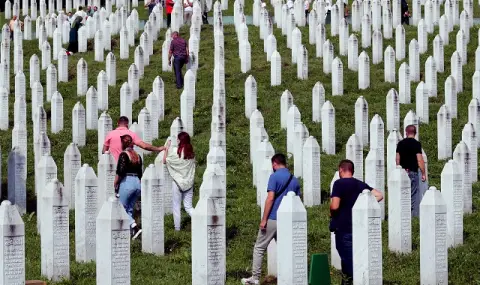One of the worst crimes since World War II is the Srebrenica massacre in which over 8,000 Muslims were slaughtered. Serbia still claims that there was no genocide. And Srebrenica is forever marked by death.
"You and the baby go through, but the little one is going there,”, one of the soldiers said to my mother, and she just froze in shock. But another soldier intervened and said: "Let the child go, we already have many like him". And then the one who wanted to separate me pushed me back to my mother and together we went to the bus, which meant our salvation,'' recalls Adem Mehmedovic, who survived the genocide in July 1995. He was an 8-year-old boy then.
Ten years ago he returned to Srebrenica, where he now lives and works in the municipal administration. Regarding the UN's decision to declare an International Day of Remembrance for the Victims of the Srebrenica Genocide, he says: "This is only a symbolic gesture and satisfaction for the victims. And the World Organization certainly bears part of the responsibility for the genocide in Srebrenica.
Attack over protected area
When war broke out in the former Yugoslav Republic of Bosnia and Herzegovina in April 1992, the town of Srebrenica was mostly populated by Bosnian Muslim Bosniaks. However, there were also villages in the neighborhood inhabited by a predominantly Serbian population.
In 1993, the UN Security Council declared the Srebrenica enclave a protected area. About 170 lightly armed soldiers, originally Canadian and later Dutch, were stationed there as a defensive force. When Bosnian Serb army units under their commander-in-chief Ratko Mladic entered the protected area on 11 July 1995, the Dutch UN soldiers surrendered without resistance. And then the army and police of Republika Srpska and the Serbian special military unit “Scorpions“ massacred more than 8,300 Bosnian men and boys.
Later, the International Tribunal for the former Yugoslavia defined the crime as genocide. In 2007, the UN International Court of Justice in The Hague also confirmed this, but ruled that Serbia was not directly involved in the genocide. According to the court, however, the authorities in Belgrade did not do anything to prevent the crime.
In Potocari, south of Srebrenica, 6,751 victims of the massacre were buried. There is a memorial there today in their memory. The remains of many other victims are still being searched for. In various trials before the International Tribunal for the Former Yugoslavia, nearly 50 people were convicted of the genocide and crimes in Srebrenica, including the two then leaders of the Bosnian Serbs, Ratko Mladic and Radovan Karadzic.
The Serbian narrative: massacre, not genocide
The Republika Srpska and Serbia dispute that the crimes in Srebrenica were genocide. In 2010, the Serbian parliament condemned the Srebrenica massacre without calling it genocide. The current UN resolution was interpreted by Serbia as an attack on the country, although Serbs are not mentioned at all in the text of the resolution.
In today's Srebrenica, it is difficult to find Serbs willing to talk about the subject. Most of them just wave their hand and say, "Don't ask me." One of them still agrees, but on the condition that he will remain anonymous. He himself was a Serbian soldier and claims that there was no genocide in Srebrenica. "If genocide is the intention to exterminate and destroy an entire people, then such a thing did not happen here," he says. He emphasized to DV that he witnessed how, at the beginning of the war, Bosniaks also killed children, women and elderly people in the Serbian villages in the area.
Such crimes did occur, but they cannot be compared to the mass massacres of Bosnian Muslims, nor did the Bosnian army carry out "ethnic cleansing".
Srebrenica – ghost town
After the war, the population of Srebrenica has decreased by two-thirds compared to the time before it: a total of about 13,000 people live in the city and the surrounding villages, only a small majority of whom identify as Bosniaks. Today, Srebrenica looks like a ghost town. There are almost no shops, and no bus stops. There are only two cafes and a few betting shops, and after 5:00 pm the deserted and empty streets are only roamed by stray dogs and occasional police patrols. You can't even buy a newspaper in Srebrenica. Young people leave the city because they do not see any prospects for themselves.
"Serbia was obliged to take the initiative for this resolution itself, in order to relieve some of the guilt of the Serbian people. It should have condemned individuals instead of becoming a haven for war criminals,'' says Sulej Canovic, who was a medic in Srebrenica during the war. He adds: "The resolution is not binding on anyone, but Bosnians have been waiting for it for a long time, because it still recommends that UN member states commemorate the genocide in Srebrenica and include the topic of it in their educational programs. It is good that July 11th is the Day of Remembrance of the Innocent Victims of Genocide."
The resolution was proposed by Germany and Rwanda. Its final version includes the Montenegro amendment, which states that criminal responsibility for genocide under international law is individual and cannot be attributed to any ethnic, religious or other group or community as a whole.
